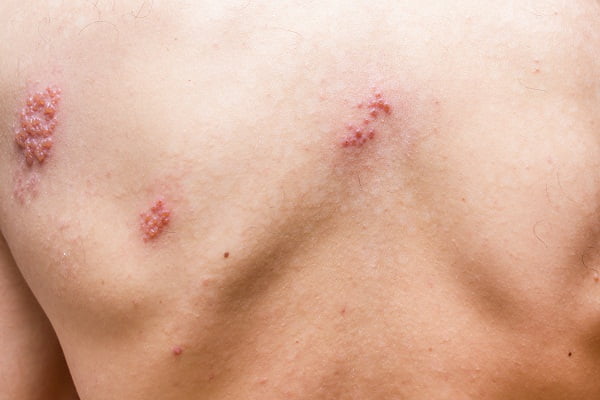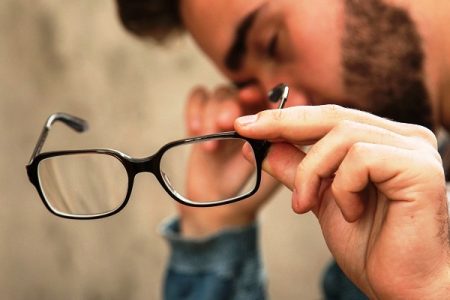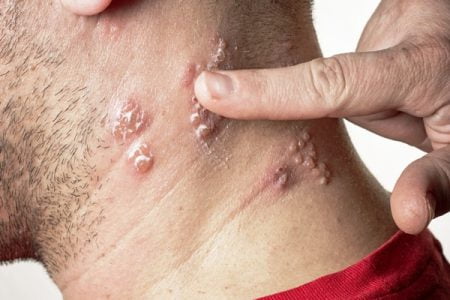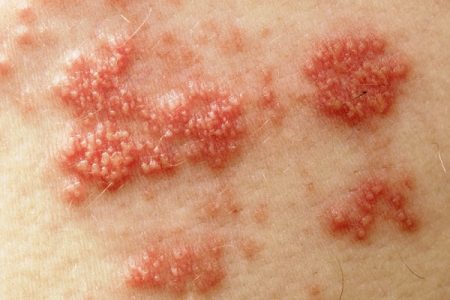Is it shingles?
Shingles is a painful skin rash which is caused by the varicella zoster virus. This is the same virus that causes chickenpox and hence these both diseases are paired up.
After recovery from chickenpox, the virus lies inactive in the central nervous system. And latter this disease is caused by reactivation of the varicella zoster virus. Although this can occur anywhere on your body, it most often appears as a single stripe, a band, or a small area of blisters around either side of the face or body.
It is a rash with shooting pain, with fluid filled blisters. These blisters ideally start to dry out and crust over within 7 to 10 days. Read more about signs and symptoms of shingles here.
Overview of Shingles
Shingles, also called herpes zoster, zoster or zona is common in adults and individuals with a weakened immune system. Anyone who has recovered from chickenpox, be it a child or an adult, can get shingles. The characteristic rash of this disease usually appears after an initial period of burning, tingling, itching or stinging in the affected area.
Around 1 in 3 people develop shingles during their lifetime.
Most people diagnosed with it are above the age of 60. There is no cure for shingles as such. A vaccine may prevent shingles or lessen its effects. The vaccine named Zostavax is approved by the FDA for the same.
Though not a life-threatening disease, but shingles can be extremely painful. The inflammation in the nerve causes this pain. It can’t be cured once infected, however early treatment can lessen how long it lasts and makes early recovery.
Upon diagnosed with shingles, doctors usually begin treatment with antiviral medicines. Milder cases of the disease are observed in children and younger people.
Read about diagnosis of shingles.
Read about treatment of shingles.
Types of Shingles
Shingles can be characterized as localized, disseminated or internal depending on where the rashes appear on the individual’s body and which systems of the body are affected. Various types are discussed below.
Localized Shingles
In this particular type, the rash with blisters is observed in a localized area. Usually, the rash develops in a single, wide stripe either on the left or right of the body or face.
Disseminated Shingles (wide rash)
In individuals with weak immune system, this particular type of shingles is observed. Large numbers of skin lesions are seen outside either the primarily affected dermatome or dermatomes directly adjacent to it. In addition to it, vital organs such as liver or brain are affected too.
Internal Shingles or Systemic Shingles
Rashes and blisters are not seen in this particular type as this affects the nerves in the body. Flu-like symptoms are commonly observed. Certain other symptoms of internal shingles can be very dangerous and can cause severe complications to the body if not diagnosed early.
Risk Factors
Shingles is commonly observed in individuals who have previously been exposed to the varicella zoster virus. Some individuals are more prone to get shingles. These include:
- Shingles in adults: Increased age (50 years or older). Our immune systems weaken as we grow older, therefore shingles in adults is much more likely to occur.
- Weakened immune system (certain cancers like leukemia, lymphoma and human immune-deficiency virus or any other diseases)
- Stress
- Injury
- Certain medicines or long term use of steroids
- Any physical trauma
Is Shingles Contagious?
Shingles cannot be transmitted from one person to another. Fluid from the blisters is contagious and can cause chickenpox (but not shingles).
People with shingles should avoid a close contact with other people till the rash blisters gets healed fully.
Special care needs to be taken to avoid contact with people who are at special risk from chickenpox. The transmission of the virus to others can be prevented by covering the shingles sores with a type of dressing that absorbs fluid and protects the sores. Individuals who get this disease usually have only one attack in their lifetime. However, certain others can have a second or even a third attack.
Complications (Effects of Shingles)
The most common complication of this disease is a condition called post-herpetic neuralgia (PHN). Individuals with PHN develop severe pain in the areas where they had the shingles rash, even after the rash disappears.
Typically, this condition resolves in a few weeks or months in most patients. However, others can have pain from PHN for several years. Other complications include:
- Eye involvement
- Encephalitis
- Disseminated herpes zoster
Shingles in adults: Who’s at risk?
Although anyone who has had chickenpox or the chickenpox vaccine can get shingles at any age, but the disease generally occurs in people who are aged older than 50 years. People who are in their 70s are much more likely to get shingles than younger adults. Shingles in adults is quite common and therefore, the guidelines for vaccination are prescribed for old age people to prevent shingles in adults.
Shingles can also be seen in people with weakened immune systems, such as people with cancer, who had organ transplants, with autoimmune diseases, having HIV/AIDS, and pregnant women.
Recurring shingles: Will My Shingles Come Back?
Shingles affects about 1 million people in the United States each year and most cases are associated with adults. Most people who have shingles will not get it again, although on rare occasions it can appear again.
Recurring shingles or recurrent shingles is that shingles which reappear after someone having it once. If you’ve had shingles once, you probably won’t get the recurring shingles again. But this doesn’t mean it can’t happen, it’s only unlikely but not impossible. Though rarely, but recurring shingles can occur a second or, rarely, a third time. However, there are ways to prevent it, or ease it the next time.
Is recurring shingles (recurrent shingles) quite common? How often does a shingles return?
It is not known exactly how many people get shingles twice or thrice. But it is clear that recurring shingles come more often in people who have a weakened immune system. If your immune system is healthy, your chances of getting the recurring shingles or recurrent shingles are extremely low. According to one study of people over age of 60 years, it was found that only 1% got recurring shingles within about 3 years. If you get shingles once, it lowers your odds of getting it a second time. The chances of getting it a third time are even much lower.
What causes shingles to flare up again?
Some common situations when recurring shingles can occur to cause the symptom and flare ups appear again are:
- When you have a weakened immune system
- If you have a cancer
- If you are pregnant
- If you have any autoimmune disease
- If you have HIV/AIDS







